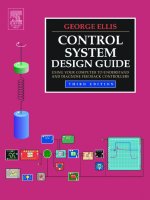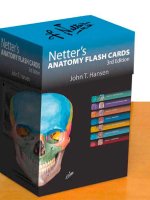Netters anatomy flash cards (3rd ed )
Bạn đang xem bản rút gọn của tài liệu. Xem và tải ngay bản đầy đủ của tài liệu tại đây (25.85 MB, 677 trang )
www.studentconsult.com
Activate
Online
For more effective study
■ Access the complete set of cards and bonus cards
■ Study with bonus multiple choice questions
REGISTER your PIN online now at
www.studentconsult.com
How to Register:
1 Gently scratch off the surface of the sticker at right
with the edge of a coin to reveal your PIN code.
2 Visit www.studentconsult.com.
3 Follow the simple registration instructions.
Scratch off the panel
below for your PIN.
NOTE: Product cannot be returned once panel is
scratched off.
Activate your PIN today at www.studentconsult.com
Access to, and online use of, content through the STUDENT CONSULT website is for individual use only; library and institutional access and use
are strictly prohibited. For information on products and services available for institutional access, please contact our Account Support Center
at (+1) 877-857-1047. Important note: Purchase of this product includes access to the online version of this edition for use exclusively by the
individual purchaser from the launch of the site. This license and access to the online version operates strictly on the basis of a single user per
PIN number. The sharing of passwords is strictly prohibited, and any attempt to do so will invalidate the password. Access may not be shared,
resold, or otherwise circulated, and will terminate 12 months after publication of the next edition of this product. Full details and terms of use
are available upon registration, and access will be subject to your acceptance of these terms of use.
1600 John F. Kennedy Blvd.
Ste 1800
Philadelphia, PA 19103-2899
NETTER’S ANATOMY FLASH CARDS
ISBN: 978-1-4377-1675-7
Copyright © 2011, 2007, 2002 by Saunders, an imprint of Elsevier Inc.
All rights reserved. No part of this book may be produced or transmitted in any
form or by any means, electronic or mechanical, including photocopying, recording
or any information storage and retrieval system, without permission in writing from
the publishers. Permissions for Netter Art figures may be sought directly from
Elsevier’s Health Science Licensing Department in Philadelphia PA, USA: phone
1-800-523-1649, ext. 3276 or (215) 239-3276; or email
Notice
Knowledge and best practice in this field are constantly changing. As new
research and experience broaden our knowledge, changes in practice, treatment
and drug therapy may become necessary or appropriate. Readers are advised to
check the most current information provided (i) on procedures featured or (ii) by
the manufacturer of each product to be administered, to verify the recommended
dose or formula, the method and duration of administration, and
contraindications. It is the responsibility of the practitioner, relying on their own
experience and knowledge of the patient, to make diagnoses, to determine
dosages and the best treatment for each individual patient, and to take all
appropriate safety precautions. To the fullest extent of the law, neither the
Publisher nor the Editors assumes any liability for any injury and/or damage to
persons or property arising out of or related to any use of the material contained
in this book.
The Publisher
Library of Congress Cataloging-in-Publication Data
ISBN: 978-1-4377-1675-7
Acquisitions Editor: Elyse O’Grady
Developmental Editor: Marybeth Thiel
Publishing Services Manager: Linda Van Pelt
Project Manager: Francisco Morales
Design Direction: Louis Forgione
Printed in China
Last digit is the print number: 9 8 7 6 5 4 3 2 1
Working together to grow
libraries in developing countries
www.elsevier.com | www.bookaid.org | www.sabre.org
Table of Contents
Section 1: Head and Neck
Section 2: Back and Spinal Cord
Section 3: Thorax
Section 4: Abdomen
Section 5: Pelvis and Perineum
Section 6: Upper Limb
Section 7: Lower Limb
Netter’s Anatomy Flash Cards, 3rd Edition
Preface
Congratulations! You have just purchased the most popular and comprehensive set
of anatomy flash cards available. Netter’s Anatomy Flash Cards offer a unique learning
resource to supplement the anatomy textbook, atlas, or dissection materials used in
medical, dental, nursing, allied health, and undergraduate courses in human anatomy. This
set of cards draws on the timeless medical illustrations of Frank H. Netter, MD, and includes
not only the musculoskeletal system but also a review of important nerves, vessels, and
visceral structures not commonly found in traditional flash card sets.
Each 4 × 6 full-color card details human anatomy as only Netter can. The set is
organized regionally in accordance with Netter’s widely popular Atlas of Human Anatomy
(i.e., Head and Neck; Back and Spinal Cord; Thorax; Abdomen; Pelvis and Perineum; Upper
Extremity; Lower Extremity). Within each region, cards are arranged sequentially as follows:
Bones and Joints; Muscles; Nerves; Vessels; and Viscera. Moreover, the image on each
card is referenced to the original plate in the Atlas of Human Anatomy, 5th Edition. Because
each section opening card is slightly taller, you can easily pull out an entire section of cards
for study. In addition, a corner of each card is prepunched so that you can insert it on the
enclosed metal ring to keep an entire section of cards in the correct order.
Each card includes a Comment section, which provides relevant information about the
structure(s) depicted on the front of the card, including detailed information for muscle
origins, insertions, actions, and innervation. Most cards also contain a Clinical section that
highlights the clinical relevance of the anatomy depicted on the front of the card. Bonus
online content is available at www.studentconsult.com using the scratch-off PIN code on
the first card. Online content includes over 300 multiple-choice questions to test your
retention of the material. Over 20 bonus flash cards from other card sets within the Netter
family of flash cards are also available on Student Consult. These cards offer an accurate
and ready source of anatomic information in an easy-to-use and portable format.
Consensus regarding the specific anatomic details of such topics as muscle attachments
or the range of motion of joints can vary considerably among anatomy textbooks. In fact,
human anatomic variation is common and normal. Consequently, the anatomic detail
provided on these cards represents commonly accepted information whenever possible.
I am indebted to and wish to credit the following superb sources and their authors or
editors:
Gray’s Anatomy for Students, 2nd ed. Drake R, Vogl W, Mitchell A. Philadelphia, Elsevier,
2010.
Gray’s Anatomy, 39th ed. Standring S. Philadelphia, Elsevier, 2005.
Netter’s Clinical Anatomy, 2nd ed. Hansen JT. Philadelphia, Elsevier, 2010.
Clinically Oriented Anatomy, 6th ed. Moore KL, Dalley DR, Agur AMR. Philadelphia,
Lippincott Williams & Wilkins, 2010.
Grant’s Atlas of Anatomy, 12th ed. Philadelphia, Lippincott Williams & Wilkins, 2009.
Hollinshead’s Textbook of Anatomy, 5th ed. Rosse C, Gaddum-Rosse P. Philadelphia,
Lippincott Williams & Wilkins, 1997.
My hope is that the Netter Flash Cards will make learning more enjoyable and
productive, and that the study of anatomy will inspire you with a sense of awe and respect
for the human form.
John T. Hansen, PhD
Professor and Associate Dean
Department of Neurobiology and Anatomy
University of Rochester Medical Center
Rochester, New York
Netter’s Anatomy Flash Cards
(978-1-4377-0272-9)
Netter’s Clinical
Anatomy, 2nd Edition
Get Nette
r flash card
Available
apps!
fro
www.itun m the App Store at
es.com/app
store/
products at your local medical bookstore or visit www.elsevierhealth.com.
(978-1-4160-4702-5)
(978-1-4160-5951-6)
Look for these and other great Netter
Netter’s Anatomy
Coloring Book
Atlas of Human
Anatomy, 5th Edition
Netter is your map!
If the human body is your territory,
Netter’s
Physiology
Flash Cards
Netter’s
Histology
Flash
Cards
Look for these and other great
(978-1-4377-0940-7)
Netter’s
Neuroscience
Flash Cards,
2nd Edition
Get Nette
r flash card
Available
apps!
from the A
pp Store a
www.itun
t
es.com/ap
pstore/
Netter products at your local medical bookstore or visit www.elsevierhealth.com.
(978-1-4160-4628-8)
(978-1-4160-4631-8)
(978-1-4160-4630-1)
(978-1-4160-4629-5)
Netter’s
Advanced Head &
Neck Flash Cards
Netter’s
Musculoskeletal
Flash Cards
The Netter Flash Card Series
More exquisitely illustrated sets to help you review!
1
Head and Neck
Cards 1-1 to 1-84
Bones and Joints
1-1
Skull: Anterior View
1-2
Skull: Lateral View
1-3
Skull: Midsagittal Section
1-4
Lateral Wall of Nasal Cavity
1-5
Cranial Base: Inferior View
1-6
Foramina of Cranial Base: Superior View
1-7
Mandible: Anterolateral Superior View
1-8
Mandible: Left Posterior View
1-9
Temporomandibular Joint
1-10
Teeth
1-11
Tooth
1-12
Cervical Vertebrae: Atlas and Axis
1-13
External Craniocervical Ligaments
1-14
Internal Craniocervical Ligaments
1-15
Cartilages of Larynx
1-16
Auditory Ossicles
Muscles
1-17
Frontal Belly (Frontalis) of Epicranius Muscle
1-18
Occipital Belly (Occipitalis) of Epicranius Muscle
1-19
Orbicularis Oculi
1-20
Zygomaticus Major and Zygomaticus Minor
1-21
Orbicularis Oris
1-22
Depressor Anguli Oris
1-23
Buccinator
Netter’s Anatomy Flash Cards
1
Head and Neck
Cards 1-1 to 1-84
1-24
Platysma
1-25
Muscles of Facial Expression: Lateral View
1-26
Levator Palpebrae Superioris
1-27
Extrinsic Eye Muscles
1-28
Temporalis
1-29
Masseter
1-30
Medial Pterygoid
1-31
Lateral Pterygoid
1-32
Mylohyoid
1-33
Geniohyoid
1-34
Genioglossus
1-35
Hyoglossus
1-36
Styloglossus
1-37
Levator Veli Palatini
1-38
Tensor Veli Palatini
1-39
Roof of Mouth
1-40
Superior Pharyngeal Constrictor
1-41
Middle Pharyngeal Constrictor
1-42
Inferior Pharyngeal Constrictor
1-43
Stylopharyngeus
1-44
Sternocleidomastoid
1-45
Sternohyoid
1-46
Sternothyroid
1-47
Omohyoid
1-48
Thyrohyoid
1-49
Cricothyroid
Head and Neck
Table of Contents
Head and Neck
Cards 1-1 to 1-84
1-50
Stylohyoid
1-51
Digastric
1-52
Oblique Arytenoids and Transverse Arytenoids
1-53
Posterior Cricoarytenoid
1-54
Muscles of Larynx
1-55
Scalene Muscles
1-56
Longus Capitis and Longus Colli
1-57
Cutaneous Nerves of Head and Neck
1-58
Facial Nerve Branches
1-59
Oculomotor, Trochlear, and Abducens Nerves:
1-60
Nerves of Orbit
1-61
Mandibular Nerve (CN V3)
1-62
Nerves of Nasal Cavity
1-63
Autonomic Nerves in Head
Nerves
Schema
1-64
Vestibulocochlear Nerve: Schema
1-65
Glossopharyngeal Nerve
1-66
Cervical Plexus In Situ
1-67
Superficial Veins and Arteries of Neck
1-68
Subclavian Artery
1-69
Carotid Arteries
1-70
Maxillary Artery
Vessels
Netter’s Anatomy Flash Cards
1-71
Arteries of Oral and Pharyngeal Regions
1-72
Veins of Oral and Pharyngeal Regions
1-73
Arteries of Brain: Inferior View
1-74
Dural Venous Sinuses
1-75
Schematic of Meninges
Viscera
1-76
Superficial Face and Parotid Gland
1-77
Lacrimal Apparatus
1-78
Eyeball: Horizontal Section
1-79
Anterior and Posterior Chambers of the Eye
1-80
Ear: Frontal Section
1-81
Lateral Wall of Nasal Cavity
1-82
Salivary Glands
1-83
Parathyroid and Thyroid Glands: Posterior View
1-84
Pharynx: Opened Posterior View
Head and Neck
Table of Contents
Skull: Anterior View
1
2
3
10
4
5
6
7
9
8
Head and Neck
1-1
Skull: Anterior View
1. Frontal bone
2. Supraorbital notch (foramen)
3. Nasal bone
4. Lacrimal bone
5. Zygomatic bone
6. Infraorbital foramen
7. Maxilla
8. Mental foramen
9. Mandible
10. Temporal bone
Comment: The skull bones are fused together at immovable, fibrous
joints, such as the sutures.
The 2 general classes of skull bones are cranial bones (8 bones),
which enclose the brain, and facial bones (14 bones). The 8 cranial
bones are the frontal, occipital, ethmoid, and sphenoid bones, a pair
of temporal bones, and a pair of parietal bones.
Associated bones of the skull include the auditory ossicles (3 in each
middle ear cavity) and the unpaired hyoid bone. The skull and
associated bones constitute 29 different bones (the 32 adult teeth
are part of the mandible and maxilla and are not counted separately).
Clinical: Le Fort midface fractures:
• Le Fort I: horizontal fracture detaching the maxilla along the
nasal floor
• Le Fort II: pyramidal fracture that includes both maxillae, nasal
bones, infraorbital rims, and orbital floors
• Le Fort III: includes the Le Fort II fracture and both zygomatic
bones
Head and Neck
Atlas Plate 4
Skull: Lateral View
1
3
2
9
4
8
7
5
6
Head and Neck
1-2
Skull: Lateral View
1. Parietal bone
2. Coronal suture
3. Sphenoid bone
4. Lacrimal bone
5. Maxilla (Frontal process; Alveolar process)
6. Zygomatic bone
7. Occipital bone (External occipital protuberance)
8. Lambdoid suture
9. Temporal bone (Squamous part; Zygomatic process; External
acoustic meatus; Mastoid process)
Comment: This lateral view shows many bones of the cranium and
some of the sutures of the skull. The coronal suture lies between the
frontal bone and the paired parietal bones. The lambdoid suture lies
between the paired parietal bones and the occipital bone.
The pterion is the site of union of the frontal, parietal, sphenoid, and
temporal bones. A blow to the head or a skull fracture in this region
is dangerous because the bone at this site is thin, and the middle
meningeal artery, supplying the dural covering of the brain, lies just
deep to this area.
Clinical: Skull fractures may be classified as:
• Linear: have a distinct fracture line
• Comminuted: have multiple bone fragments (depressed if
driven inwardly, which can tear the dura mater)
• Diastasis: a fracture along a suture line
• Basilar: a fracture of the base of the skull
Head and Neck
Atlas Plate 6
Skull: Midsagittal Section
9
1
8
2
7
3
4
Head and Neck
5
6
1-3
Skull: Midsagittal Section
1. Sphenoid bone (Greater wing; Lesser wing; Sella turcica;
Sphenoidal sinus)
2. Frontal bone (Frontal sinus)
3. Ethmoid bone (Perpendicular plate)
4. Maxilla (Incisive canal; Palatine process)
5. Vomer
6. Palatine bone
7. Occipital bone
8. Temporal bone (Squamous part; Petrous part)
9. Parietal bone
Comment: Note the interior of the cranium and the nasal septum.
The 8 cranial bones enclosing the brain include the unpaired frontal,
occipital, ethmoid, and sphenoid bones and the paired temporal and
parietal bones. The 14 facial bones include the paired lacrimal, nasal,
palatine, inferior turbinate (not shown), maxillary, and zygomatic bones
(not shown) and the unpaired vomer and mandible (not shown).
The nasal septum is formed by the perpendicular plate of the
ethmoid bone, the vomer, and the palatine bones and septal
cartilages.
The petrous portion of the temporal bone contains the middle and
inner ear cavities and the vestibular system.
Clinical: A blow to the skull that results in a fracture can tear
the underlying periosteal layer of dura mater, which can result in
an epidural (extradural) hematoma and/or leakage of the
cerebrospinal fluid.
A slight deviation of the nasal septum is common. However, if
this is severe or if deviated as a result of trauma, then it may be
corrected surgically so as not to interfere with breathing.
Head and Neck
Atlas Plate 8
Lateral Wall of Nasal Cavity
9
8
1
2
3
7
4
5
6
Head and Neck
1-4
Lateral Wall of Nasal Cavity
1. Frontal bone (sinus)
2. Nasal bone
3. Major alar cartilage
4. Maxilla (Frontal process; Incisive canal; Palatine process;
Alveolar process)
5. Inferior nasal concha
6. Palatine bone (Perpendicular plate; Horizontal plate)
7. Sphenoid bone (Sphenoidal sinus; Medial and Lateral plates of
pterygoid process; Pterygoid hamulus)
8. Ethmoid bone (Middle nasal concha; Cribriform plate; Superior
nasal concha)
9. Lacrimal bone
Comment: The lateral wall of the nasal cavity prominently displays
the superior and middle conchae (turbinates) of the ethmoid bone
and the inferior concha. Portions of other bones, including the nasal
bone, maxilla, lacrimal bone, palatine bone, and sphenoid bone,
contribute to the lateral wall.
The palatine processes of the maxillae and the horizontal plates of
the palatine bones make up the hard palate.
Clinical: The pituitary gland lies in the hypophysial fossa, a
depression seen just superior to the sphenoidal sinus in the
sphenoid bone. The pituitary gland can be approached surgically
through the nasal cavity by passing through the sphenoidal sinus
and directly into the hypophysial fossa (trans-sphenoidal
resection).
Head and Neck
Atlas Plate 37
See also Plate 8
Cranial Base: Inferior View
1
2
3
8
4
7
5
6
Head and Neck
1-5
Cranial Base: Inferior View
1. Maxilla (Incisive fossa; Palatine process; Zygomatic process)
2. Zygomatic bone
3. Sphenoid bone (Medial plate; Lateral plate; Greater wing)
4. Temporal bone (Zygomatic process; Mandibular fossa; Styloid
process; External acoustic meatus; Mastoid process)
5. Parietal bone
6. Occipital bone (Occipital condyle; Basilar part; Foramen
magnum; External occipital protuberance)
7. Vomer
8. Palatine bone (Horizontal plate)
Comment: Cranial bones and facial bones contribute to the base of
the skull. Key processes and foramina associated with these bones
can be seen in this inferior view.
The largest foramen of the skull is the foramen magnum, the site
where the spinal cord and brainstem (medulla oblongata) are
continuous.
Clinical: Basilar fractures (fractures of the cranial base) may
damage important neurovascular structures passing into or out of
the cranium via foramina (openings). The internal carotid artery
may be torn, cranial nerves may be damaged, and the dura
mater may be torn, resulting in leakage of the cerebrospinal fluid.
Head and Neck
Atlas Plate 10
Foramina of Cranial Base:
Superior View
1
2
3
4
5
6
10
7
8
11
9
12
Head and Neck
1-6
Foramina of Cranial Base:
Superior View
1.
2.
3.
Foramina of cribriform plate (Olfactory nerve bundles)
Optic canal (Optic nerve [CN II]; Ophthalmic artery)
Superior orbital fissure (Oculomotor nerve [CN III]; Trochlear
nerve [CN IV]; Lacrimal, frontal, and nasociliary branches of
ophthalmic nerve [CN V1]; Abducens nerve [CN VI]; Superior
ophthalmic vein)
4. Foramen rotundum (Maxillary nerve [CN V2])
5. Foramen ovale (Mandibular nerve [CN V3]; Accessory meningeal
artery; Lesser petrosal nerve [occasionally])
6. Foramen spinosum (Middle meningeal artery and vein;
Meningeal branch of mandibular nerve)
7. Foramen lacerum
8. Carotid canal (Internal carotid artery; Internal carotid nerve plexus)
9. Internal acoustic meatus (Facial nerve [CN VII];
Vestibulocochlear nerve [CN VIII]; Labyrinthine artery)
10. Jugular foramen (Inferior petrosal sinus; Glossopharyngeal
nerve [CN IX]; Vagus nerve [CN X]; Accessory nerve [CN XI];
Sigmoid sinus; Posterior meningeal artery)
11. Hypoglossal canal (Hypoglossal nerve [CN XII])
12. Foramen magnum (Medulla oblongata; Meninges; Vertebral
arteries; Meningeal branches of vertebral arteries; Spinal roots
of accessory nerves)
Comment: Key structures passing through each foramen are noted
in parentheses.
Clinical: Fractures or trauma involving any of these foramina
may result in clinical signs and symptoms associated with the
neurovascular elements passing through the foramen. Thus, it is
important to know these structures and their relationships to the
cranial base.
Head and Neck
Atlas Plate 13









